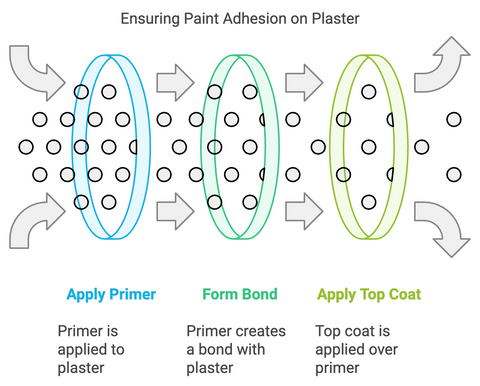Mist Coats 101!
Mist coats are one thing that comes up frequently here at Greenshop Paints Actually I learned this quite late, as I rarely painted on bare plaster, so it wasn’t until a few years later when I spotted my own ceiling peeling, which the cause turned out to be a lack of mist coat, and the previous owner just (lazily) painting the top coat emulsion over the newly dried fresh plaster. I could see the issues the lack of mist coat caused first hand.
What is a mist coat and does a new plaster need a mist coat?
Bare plaster, whether old dry plaster or freshly dried new plaster, whether gypsum, lime or clay all have one thing in common, they are super absorbent.
So, when you try and get away with using just one coat of your favourite household emulsion, in one thick coat (I’m looking at you previous house owner of my own home) as soon as the thick coat makes contact with the plaster it dries before it has a chance to bond to anything. So yes, it is stuck on there enough to last a little while, but the the slightest change in environment (for instance higher humidity like in a bathroom) it leads to peeling. The paint just can’t stay gripped to the plaster. (Check here if you need plasterboard primer paint)
So what a mist coat (or any plaster primer) does, is create that bonding layer between the plaster and the paint.
A mist coat is specifically a water thinned coat of interior paint, that can absorb into the plaster, but have enough paint surface for the top coat to adhere onto. So the mist coat penetrates into the fresh plaster and grips, and then the top coat has something to grip onto too, creating a strong layer of adhesion between the plaster and the top coat.
Fundamentally a mist coat is just a water thinned coat of your top coat. So in my own home, on my bare plaster I made a mist coat using 10% water and 90% Auro 555 Natural wall emulsion.
How long does mist coat take to dry?
Mist coat drying time depends on how warm and ventilated the room is, but I left it about a day or so, but can be quicker) I then did a normal undiluted coat of the same Auro 555 Natural wall emulsion, with a second coat the next day if it was required.
How many mist coats on new plaster
One coat is usually sufficient for most plaster, so just the one.
Should I add PVA to mist coat?
No you should not add PVA to your mist coat, it just is not required, and as a natural paint nerd that cares about plaster breathability, you are negating all breathability if you use PVA. Don’t.
Mist coat ratio - what should it be?
What ratio should a mist coat be? When I mix mix coats using Auro 555 natural wall primer, I mix 1 part water to 9 parts paint, so 10% water to 90% paint. This can vary with the paint, but anywhere between 10-20% will be the best ratio for your mist coat.

Mixing up a mist coat
For mixing your mist coat, use a paint stirrer attached to a cordless drill on a low speed, or just a mixing stick. No need to worry too much, just give it a good mix and get started.
Apply the topcoat over the mist coat
Once you have waited for your mist coat to dry, you can then apply the first coat of your top coat, knowing that you are going to get great adhesion and the best results
Does mist coat have to be white?
Mist coats don’t need to be white. The best thing about mist coats is that you are using the same paint as your top coat, so you just have a water thinned version of the colour you need.
Sometimes it can be cheaper to use a simple economy white paint as your mistcoat than actually water thinning your top coat. A good example of this is when painting with our top selling Graphenstone Grafclean Premium natural wall paint, it works out more expensive water thinning this paint to use as a mist coat, than buying the compatible Graphenstone Nevada, which acts as a simple mist coat primer and far less of a cost.
Is Matt or silk better for mist coat?
Matt is best for a mist coat as it has more texture for adhesion for the top coat.
So there you have it - mist coat is just a water thinned top coat, used to get better adherence between bare plaster and top coat.
Learn more about
Why use a plaster primer
How to paint a wall
Range of primers
Range of natural wall paints
When do I need to use a primer?
plasterboard primer paint
Paint Colour Charts & Swatches
Please consider ordering a free paint chart for an accurate look at our ranges, or a very reasonably priced paint colour swatch which you can stick to the wall, and reuse as many times as you like in different rooms. You can also browse our range of paint colours by shade.




